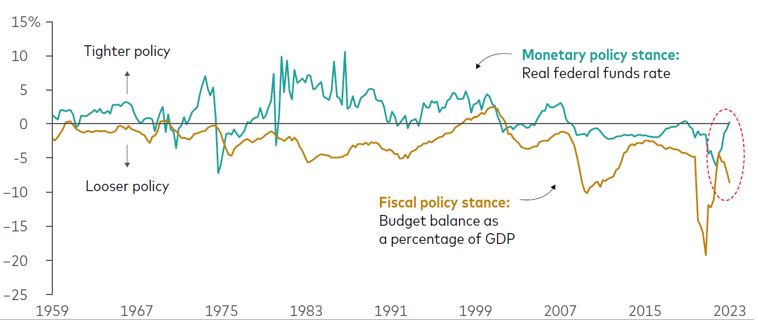
.
Over decades, U.S. fiscal and monetary policies have mostly travelled in the same direction, toward either more restrictive (tighter) or less restrictive (looser) financial conditions. Recently, though, they have diverged. Legislation intended to boost the economy after the COVID-19 pandemic has run into an aggressive series of central bank interest rate hikes meant to quell the post-pandemic recovery’s rampant inflation.

Note: The federal funds rate is the annualised rate of interest that banks charge one another for overnight loans. The Federal Reserve sets a target rate that controls the effective rate. The real (inflation-adjusted) federal funds rate is the effective federal funds rate minus the 12-month rate of core inflation (which excludes volatile food and energy prices), as measured by the Consumer Price Index. The budget balance (surplus or deficit) is for the federal government and is a rolling 12-month sum.
Sources: Vanguard calculations through June 30, 2023, using data from the U.S. Treasury, the Bureau of Labor Statistics, the Federal Reserve Bank of New York, and the Bureau of Economic Analysis.
In short, explains Josh Hirt, a Vanguard senior economist, “Monetary policy is still working its way through the economy, trying to constrain activity even as the impacts of supportive fiscal policy have kicked in. This is one of the reasons we believe the economy faces a period of higher sustained interest rates than we’ve grown accustomed to seeing.” Vanguard believes that the Federal Reserve may need to raise rates further and keep them at their highest levels for an extended period in the face of continued economic resilience.
Recent Vanguard research concludes that the “neutral rate of interest”—a theoretical rate that neither promotes nor restricts economic activity—is higher than many may have thought. That finding and our related policy analysis support our view that the Fed may need to raise its federal funds target rate by a further 25–75 basis points before ending a rate-hiking cycle that began in March 2022 and has totaled 525 basis points. (A basis point is one-hundredth of a percentage point.) The Fed’s rate target currently stands at 5.25%–5.5%. We don’t foresee the central bank cutting its target until the second half of 2024.
The views below are those of the global economics and markets team of Vanguard Investment Strategy Group as of September 13, 2023.
The Reserve Bank of Australia (RBA) has left its cash rate unchanged, at 4.1%, for three consecutive policy meetings, but something noteworthy has been missing from its statements: an indication that the bank has completed its rate-hiking cycle.
In the last significant data release before the Federal Reserve’s next policy decision, core inflation accelerated in August compared with the two previous months, the Bureau of Labor Statistics reported. Although both core and headline inflation marginally exceeded our expectations, we don’t see cause for concern. Shelter costs continue to trend lower, goods prices have been deflationary, and—outside of volatile transportation prices—services prices have been largely within expectations.
A September 15 release of data on retail and housing sales, industrial production, and fixed asset investment will say a lot about whether an economy that has struggled for several months may have hit its bottom.
The European Central Bank (ECB) announced a 25-basis-point rate hike on September 14, taking its deposit facility rate to 4%. With that, Vanguard believes the bank has reached its peak rate in a hiking cycle that began in July 2022.
Inflation and wage pressures remain strong even as high-frequency data suggest economic weakening in the third quarter.
Continued progress on inflation has enabled further interest rate cuts in Latin America. Banco Central Chile cut its key interest rate by 75 basis points on September 5, to 9.5%, following a 100-basis-point cut in late July. Banco Central do Brasil is widely expected to announce on September 19 that it will further lower its Selic rate. At its last meeting, the central bank lowered the Selic by 50 basis points to 13.25%.
Whether the Bank of Canada (BOC) has reached the end of its rate-hiking cycle may be a matter of whether slowing economic growth translates into decelerating inflation and wage growth. The BOC held its overnight rate target steady at 5.0% on September 6, noting that the Canadian economy had “entered a period of weaker growth, which is needed to relieve price pressures.”
Our 10-year annualised nominal return and volatility forecasts are shown below. They are based on the June 30, 2023, running of the Vanguard Capital Markets Model (VCMM). Equity returns reflect a range of 2 percentage points around the 50th percentile of the distribution of probable outcomes. Fixed income returns reflect a 1-point range around the 50th percentile. More extreme returns are possible.
Australian equities: 4.2%–6.2% (21.7% median volatility)
Global ex-Australia equities (unhedged): 4.8%–6.8% (19.4%)
Australian aggregate bonds: 3.8%–4.8% (5.5%)
Global bonds ex-Australia (hedged): 4.0%–5.0% (4.7%)
Notes:
All investing is subject to risk, including the possible loss of the money you invest.
Investments in bonds are subject to interest rate, credit, and inflation risk.
Investments in stocks and bonds issued by non-U.S. companies are subject to risks including country/regional risk and currency risk. These risks are especially high in emerging markets.
Important
The projections and other information generated by the Vanguard Capital Markets Model regarding the likelihood of various investment outcomes are hypothetical in nature, do not reflect actual investment results, and are not guarantees of future results. VCMM results will vary with each use and over time.
The VCMM projections are based on a statistical analysis of historical data. Future returns may behave differently from the historical patterns captured in the VCMM. More important, the VCMM may be underestimating extreme negative scenarios unobserved in the historical period on which the model estimation is based.
The Vanguard Capital Markets Model is a proprietary financial simulation tool developed and maintained by Vanguard’s primary investment research and advice teams. The model forecasts distributions of future returns for a wide array of broad asset classes. Those asset classes include U.S. and international equity markets, several maturities of the U.S. Treasury and corporate fixed income markets, international fixed income markets, U.S. money markets, commodities, and certain alternative investment strategies. The theoretical and empirical foundation for the Vanguard Capital Markets Model is that the returns of various asset classes reflect the compensation investors require for bearing different types of systematic risk (beta). At the core of the model are estimates of the dynamic statistical relationship between risk factors and asset returns, obtained from statistical analysis based on available monthly financial and economic data from as early as 1960. Using a system of estimated equations, the model then applies a Monte Carlo simulation method to project the estimated interrelationships among risk factors and asset classes as well as uncertainty and randomness over time. The model generates a large set of simulated outcomes for each asset class over several time horizons. Forecasts are obtained by computing measures of central tendency in these simulations. Results produced by the tool will vary with each use and over time.
This article contains certain 'forward looking' statements. Forward looking statements, opinions and estimates provided in this article are based on assumptions and contingencies which are subject to change without notice, as are statements about market and industry trends, which are based on interpretations of current market conditions. Forward-looking statements including projections, indications or guidance on future earnings or financial position and estimates are provided as a general guide only and should not be relied upon as an indication or guarantee of future performance. There can be no assurance that actual outcomes will not differ materially from these statements. To the full extent permitted by law, Vanguard Investments Australia Ltd (ABN 72 072 881 086 AFSL 227263) and its directors, officers, employees, advisers, agents and intermediaries disclaim any obligation or undertaking to release any updates or revisions to the information to reflect any change in expectations or assumptions.
© 2023 Vanguard Investments Australia Ltd. All rights reserved.
By Vanguard
September 2023
vanguard.com.au
Hot Issues
October - December 2023 archive